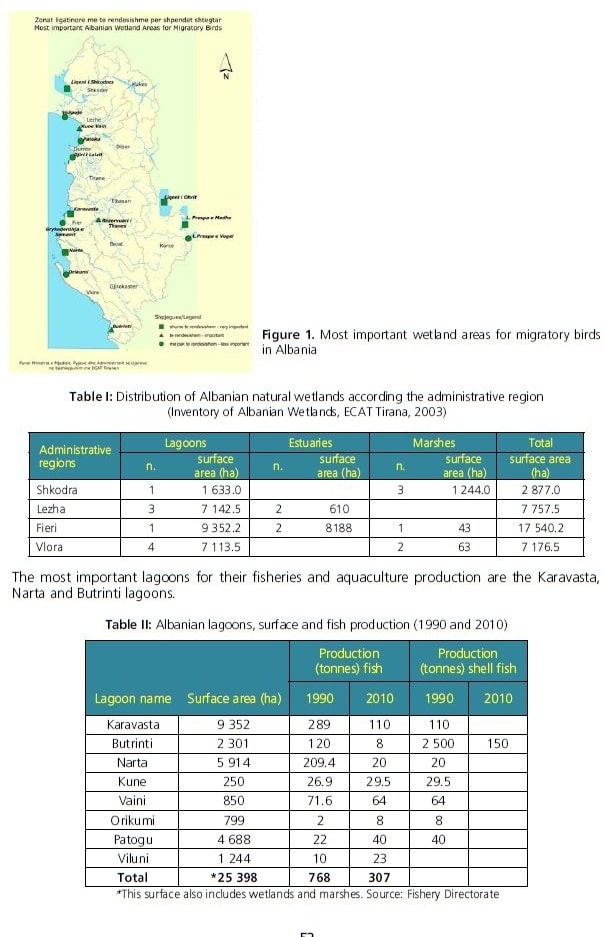1.2 Generalities on coastal lagoons
Albanian lagoons represent a very important environment. These lagoons present multiple assets, both at the ecological and economic level. It is estimated that coastal lagoons are the most productive ecosystems, owing to their position between land and sea.
In countries with high biodiversity, such as Albania, the contribution of wetlands is essential. Their protection and their preservation have been identified as a priority not only by environmental institutions, but also by numerous non-governmental organizations. International technical and financial assistance is necessary to support efforts towards the preservation of Albania’s natural heritage.
Coastal lagoons are particular aquatic sites within the Albanian hydrographic network. They typically stretch along the coastline and they are separated from the sea by a narrow strip of land, of alluvial origin, which in most cases appears as a long cord with littoral sand dunes. The coastal lagoon shaping process is closely linked to the continuous accumulation of sediments that are carried and shed from rivers to the sea.
The main Albanian coastal lagoons are Karavasta, Butrinti, Narta, Kune-Vaini, Orikum, Patogu and Viluni. There are some other small lagoon areas, like Kallenga and Lumi I Kripur near Narta, and Murtemsa near the Viluni lagoon.
In general, the depth of Albanian coastal lagoons is relatively low. The limnology regime of coastal lagoons can mainly be determined by dynamic processes of communication between the sea and lagoons through several channels.
The eight Albanian coastal lagoons are located in two distinct geographic areas: the Adriatic and the Ionian Sea coastal areas. Seven lagoons (from north to south: Viluni, Kune, Vain, Patog, Karavasta, Narta and Orikumi) are situated along the Adriatic coastline and only one (the Butrinti lagoon) belongs to the Ionian coastline.
The climate of the Albanian littoral lowlands is typically Mediterranean. Annual precipitation rates range from 930 to 2 200 mm; annual temperatures vary between 15–16.5°C, increasing from north to south and from west to east. The number of frosty days is 5?30 every year, maximum temperatures are 42.2?43.9°C and minimum ones range from - 3.5 to -7.2°C.
Figure 1. Most important wetland areas for migratory birds in Albania
Table I: Distribution of Albanian natural wetlands according the administrative region (Inventory of Albanian Wetlands, ECAT Tirana, 2003)
The most important lagoons for their fisheries and aquaculture production are the Karavasta, Narta and Butrinti lagoons.
Table II: Albanian lagoons, surface and fish production (1990 and 2010)

*This surface also includes wetlands and marshes. Source: Fishery Directorate 52
The Adriatic coastal lagoons continuously undergo erosion processes affecting not only their structure but also their communication with the sea. As a result of this poor communication between lagoons and the sea, some lagoons are affected by salinity increase (Narta and Karavasta lagoons) and high levels of eutrophication (Vaini and Karavasta lagoons). Moreover, decreasing freshwater flows into the lagoons have damaged the fragile equilibrium of the lagoon mouth. This phenomenon is typical in the Karavasta, Narta and Vaini lagoons. The Ionian coastal lagoons, like Orikumi and Butrinti, are not affected by this problem thanks to the rocky structure of the area.
According to their origin, Albanian cosatal lagoons can be divided as follows:
• Alluvium sedimentation from the rivers: Viluni, Vaini, Kune, Patogu, Narta and Karavasta lagoons
• Tectonic: Knalla, Orikumi andButrinti lagoons.
Albanian coastal lagoons are important for coastal communities, in particular as far as fisheries are concerned, but they also offer opportunities for agriculture, forestry, hunting, ecotourism and cultural activities. Karavasta, Narta and Brutrinti are among the most representative lagoons.
All Albanian lagoons are national resources and are managed by the State.
Table III: Environmental institutional framework of Albanian lagoons
Source: Biodiversity Directorate. Ministry of Environment, Forestry and Water Administration IBA (International Bird Area), SPA (Specific Protected Area)

The main laws related to lagoon areas in Albania are the following:
• Law n. 7908, date 5.4.1995 on “Fishery and Aquaculture”;
• Law n. 10431, date 9.6.2011 on “Environment protection”;
• Law n. 9584, date 20.7.2006 on “Biodiversity protection”;
• Law n. 9867, date 31.1.2008 on “Rules and procedures determining on international market of endangered wild fauna and flora species”;
• Law n. 10006, date 23.10.2008 on “Wild fauna protection”;
• Law n. 9385, date 4.5.2005 on “Forestry and forestry unit mission”; • Law n. 10253, date 11.3.2010 on “Hunting”, etc.